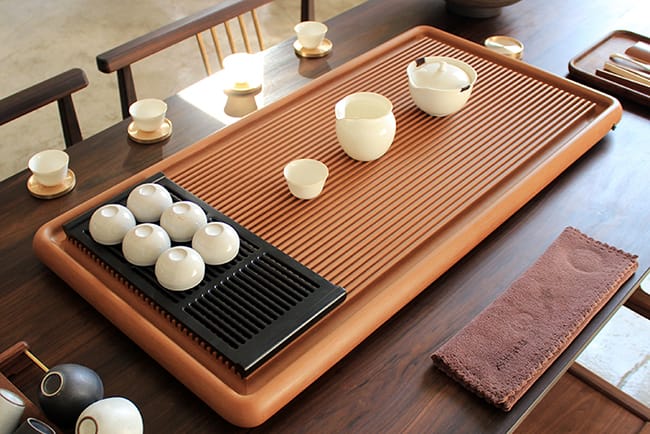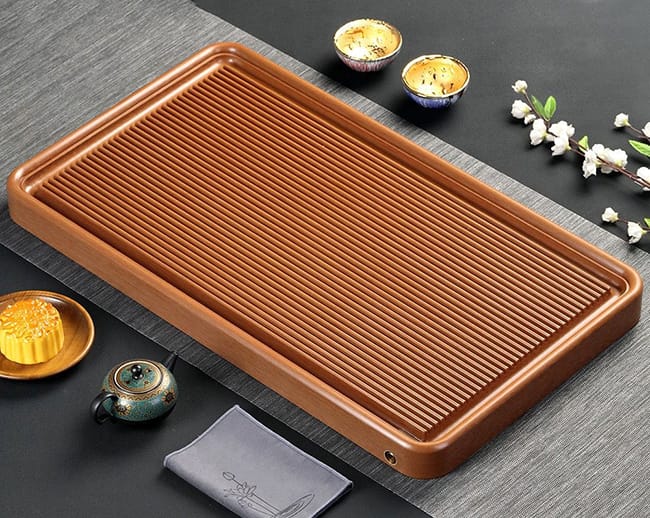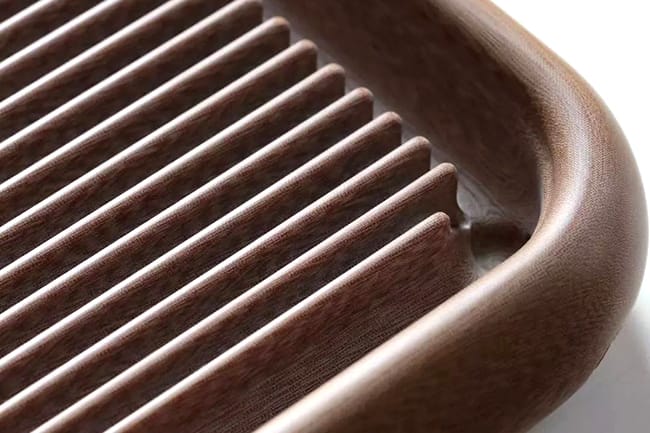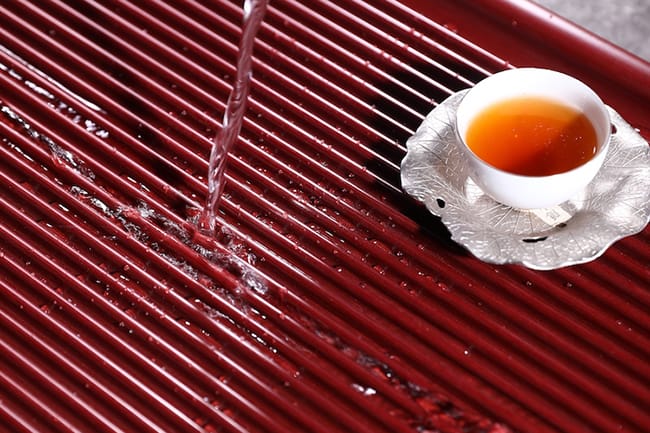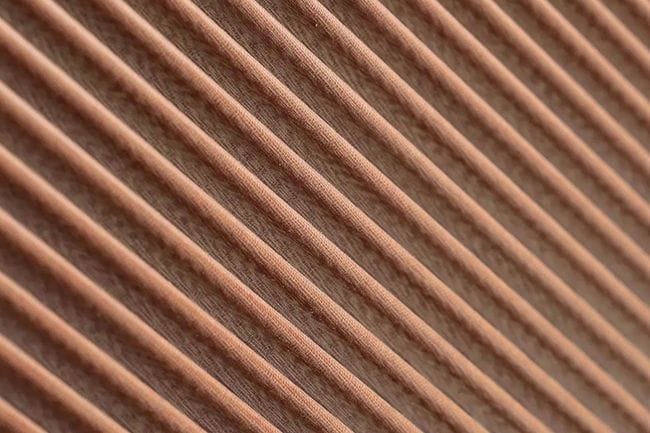Last Updated on 01/10/2022 by Desmond
For a long time, the bakelite tea tray gives a plain and twopenny impression. Its style is onefold and straightforward; the color looks intentionally imitating wood but lacks anima. Actually, just talk about the practicability, bakelite tea tray may be the best teaware for one who begins tea learning.
CONTENT
What Is Bakelite Tea Tray
First, we need to know what is bakelite.
Bakelite is a type of synthetic plastic called polyoxybenzylmethylenglycolanhydride, invented by Leo Baekeland, a Belgian-American chemist, in 1907. Bakelite has many advantages, including waterproof, insulating, and high-temperature resistance. It is an excellent industrial material.
The tea tray is actually made from a bakelite sheet. Piling the cotton gauze together, steep them into the molten bakelite, then compress tight by the punching machine, finally cool down for shaping to get a sheet. Thie industrial material is often used to produce the parts of various commodities.
In the 1980s, a Taiwanese tea lover called Cai, who engaged in CNC machining work, suddenly whim and used a bakelite sheet to make a tea tray for private use.
This bakelite tea tray had a simple design, the color looks similar to mahogany, most of all, it’s low cost. Cai’s friends thought the tray was awesome and asked him to make several more for them. Since then, the bakelite tea tray has become popular in Taiwanese tea lovers groups.
At the most beginning, bakelite tea tray undoubtedly belongs to the low-grade teawares. Until it got more and more popular, the merchants found the opportunity. They began developing special bakelite sheets for making tea trays and set the standard production process. Today, some high-grade bakelite tea trays’ prices have already been close to the mid-end stone and wood tea tray.
The Advantages of Bakelite Tea Tray
The bakelite tea tray has various advantages, except for the favorable price.
Sturdy and Durable
The pure bakelite is fragile. However, the bakelite sheet for making tea trays has multiple layers of cotton gauzes inside. They are like the steel in the concrete, strengthening the sheet much. The punching machine will compress these cotton gauzes and bakelite to dozens of millimeters during the processing, turning them into one rock-solid plate.
Compared with the others, the bakelite tea tray has a stabler physically. It won’t craze or be out of shape by the thermal expansion and contraction or break by a slight impact. And it is also light. People describe bakelite tea tray exaggeratively that it can used for over a millennium.
Protecting the Teawares Better
The tea tray is the operating deck when drinking tea and the storage room for teawares. An over-hard surface will easily break the teawares by a misoperation (dropping them or rudely preparing.) This situation is often happening to a stone tea tray; even a slight rub will make the glaze of the porcelain teawares bottom drop out.
Although the bakelite tea tray is as strong as the stone one, its surface hardness is much lower, even a certain springy. It is very friendly to fragile teawares like glass and ceramic ones. Plus, there are ditches from the special drainage design that provides enough space, which helps reduce the impact from the teawares falling and protect them better.
Excellent Drainage Performance
Almost all the bakelite tea tray has drainage ditches, which are created by engraving. The wastewater can flow away down the drain during the tea preparation, keeping the tray clean and tidy. The teawares’ bottom can also stay dry, won’t form the water stain lead to collection value reduction.
This design seems so ingenious, and why is it rarely seen on the tea trays made from other materials?
That’s because only bakelite is completely nonabsorbent. If to use this design on the wood and stone tea tray, the rough and absorbent surface can not let the water flow away smooth, instead of permeating to the inside. Of course, it is also an advantage to the tea lovers who are interested in raising teawares. And to the ceramic tea tray, it is hard to realize this design, and it will make the glaze easier to fall off.
The Disadvantages of Bakelite Tea Tray
Lack of Styles
Even though bakelite belongs to plastic, its plasticity reduces significantly after being processed into a sheet. It can only be further processed by the carving and cutting machines. The processing of the bakelite tea tray is also complicated; after the machining process, it still needs a long time of manual polishing.
So the bakelite tea trays we see are almost the same, no more than the difference on rounded or square-shaped. This simple design increases the yield but lacks styles and ornamental value.
Has No Collection Value
How to say, tea culture originated in China, the interest of drinking tea is easy making people associating with the ancient oriental culture or the highly artistic Sado. Wood, stone, ceramic, and even glass teawares can satisfy this requirement well. Their natural texture and craft also make them unique and valuable.
But, bakelite is a synthetic plastic and worthless itself. And it is hard to get an excellent appearance because of the low plasticity(even it does, it is easy to clone.) So the bakelite tea tray has no qualification to become a teaware that is worthing collection, even those high-grade ones. Compared with the teawares in other materials, this can be said to be an insurmountable disadvantage of the bakelite tea tray.
Potential Hazardous to Health
When the bakelite tea tray just became popular, it was made from the industrial sheet material, without the safe qualification of direct food contact. The bakelite sheet smells pungent and will be worse after contacting hot water. This odor is undoubtedly not safe for health; it typically leads to emesis, diarrhea, and dizziness.
Fortunately, now the bakelite sheets for making tea trays are improved and safe for the body. The products sold on the market must pass the safe food direct contact tests. However, there are still many bakelite tea trays at a marvelous low price sold on the internet. They may be made from recycled waste bakelite or industrial sheets; they are at risk to health and need to pay attention to.
How To Pick An Appropriate Bakelite Tea Tray
With the popularity of the bakelite tea tray growing, its craft and grade also get plentiful. According to the following 4 sides, you can simply know whether a tea tray can satisfy your requirements and is worth the price.
Yarn Count
We know that the bakelite sheet is made from cotton gauze, and the yarn count is an essential parameter about the grade; it indicates the density of the cotton gauze.
Look at the bakelite tea tray’s surface, and you will see there are wood-like textures, but not so much natural. These textures are formed by the cotton gauze inside. The higher the yarn count, the more delicate the textures will be; also, the price gets higher. Except for better looking, the bakelite tea tray in higher yarn count also has stronger strength.
The common yarn count is 21Nm, 30Nm, and 32Nm. For supply chain reasons, most 32Nm bakelite tea trays are yellow, 30Nm ones show ebony, and 21Nm ones show mahogany. Of course, the yarn count is not absolutely equal to the color; it is just the most cases.
One thing worthing to know, typically, the highest grade of bakelite tea tray sold on the market is 32Nm. Someone describes a higher yarn count maybe is false advertising.
Surface Treatment Process
Although machines carry out the primary processing, the subsequent polishing of the bakelite tea tray still needs to be done in manual work.
The polishing job is challenging and requires an elaborate operation. The laser engraving in primary processing makes the edge sharp and surface rough. Polishing in a hand way can ensure a consistent smoothness and a more natural arc. Especially to the four interior angles inside, the wastewater often accumulates there and impacts the drainage if it is not polished smooth enough.
Except for the polishing, some bakelite tea trays may get oil-applied. The manufacturers will apply some oil on the tray’s surface, making it looks more glossy and bringing a certain protective effect. Most of the time, they love to use walnut oil, which has excellent permeability and can make the tea tray color more similar to the natural wood.
Drainage Smoothness
Suppose the wastewater accumulates in the tea tray and can not flow away. In that case, your teacups‘ bottom keeps wet; that shows no respect when you are serving guests. It also makes a bad experience.
Pour a cup of water into the tea tray, see whether the water can flow away down the drain grooves to the hole and if there are any depressions left the water behind.
You also need to check the drain hole. Many times the loose leaves block the hole. If the inlet side of the hole has a long distance to the outlet side, it will make the clean job challenge.
Smell
This is the most important factor in judging a bakelite tea tray’s quality. An eligible bakelite tray is almost odorless, no matter what grade it is. If the tea tray smells pungent or has a strange fragrance, you should never buy it, even if it has an awesome price or an excellent looking.
How To Maintain A Bakelite Tea Tray
The daily maintenance job of a bakelite tea tray is simple. All you need to do is clean it with a soft towel every time after using it and dry it thoroughly. This is for not to leave any water and tea stains. Besides, because bakelite belongs to an inorganic substance, you don’t worry that it will bread mold like the wood tray.
Some new bakelite tea trays look whitish, especially the ones without oil-applied. This is because of the imperfect polishing craft, or the masters didn’t clean up all the chippings and applied oil directly. This whitish situation will go after several times using and cleaning.
On ordinary days, you can use a soft towel, dip a few walnut oils, and wipe the tray gently, making it more glossy. Pay attention not to use too much oil, or it will make the tray become greasy, and it’s also not friendly to the clay teawares like Zi Sha(they absorb oil.)
After a long time using and the soakage of tea, the surface of a teaware will get a sign of aging and better looking. Tea lovers call it “raising a teaware.” It also makes the teaware becomes more valuable.
Although the bakelite tea tray is not made from a natural material, some tea lovers still love raising it. A bakelite tea tray after a long time raising, the color indeed looks more similar to the natural wood; however, the value won’t increase.

